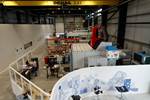First A380 powered by 100% sustainable aviation fuel takes to the skies
This is the third Airbus aircraft type to fly on 100% SAF over the course of 12 months, following an Airbus A350 and A319neo, with a goal of 100% certification for all Airbus aircraft at the end of this decade.
Share
Read Next

Photo Credit: Airbus SAS, Adoumenjou/Master Films
On March 28, (Toulouse, France) performed a first A380 flight powered by 100% sustainable aviation fuel (SAF), per its commitment defined in the Feb. 4 signing of the Toulouse Declaration.
Airbus’ A380 test aircraft MSN 1 took off from Blagnac Airport, Toulouse, France, on March 25, 2022. The flight lasted about three hours, operating one (London, U.K.) Trent 900 engine on 100% SAF.
Airbus says 27 tonnes of unblended SAF were provided by (Courbevoie, France) for this flight. The SAF produced in Normandy (close to Le Havre, France) was made from hydroprocessed esters and fatty acids (HEFA), free of aromatics and sulphur, and primarily consisting of used cooking oil, as well as other waste fats. A second flight, with the same aircraft, took place from Toulouse to Nice Airport on March 29, to test the use of SAF during takeoff and landing.
This is the third Airbus aircraft type to fly on 100% SAF over the course of 12 months; the first was an Airbus A350 in March 2021 followed by an A319neo single-aisle aircraft in October 2021.
Increasing the use of SAF remains a key pathway to achieving the industry’s ambition of net-zero carbon emissions by 2050, Airbus says. Key statistics outlined in the Waypoint 2050 report indicate that SAF could contribute between 53-71% of required carbon reductions.
All Airbus aircraft are currently certified to fly with up to a 50% blend of SAF mixed with kerosene. The aim is to achieve certification of 100% SAF by the end of this decade.
The A380 aircraft used during the test is the same aircraft recently revealed as Airbus’ ZEROe Demonstrator, a flying testbed for future technologies instrumental to bringing a zero-emission aircraft to market by 2035.
Related Content
-
Bladder-assisted compression molding derivative produces complex, autoclave-quality automotive parts
HP Composites’ AirPower technology enables high-rate CFRP roof production with 50% energy savings for the Maserati MC20.
-
Partners recycle A350 composite production waste into adjustable-length rods for MFFD
Herone, Spiral RTC, Teijin Carbon Europe and Collins Aerospace Almere recycle A350 thermoplastic composite clips/cleats waste into rods for the all-thermoplastic composite Multifunctional Fuselage Demonstrator’s crown.
-
ASCEND program completion: Transforming the U.K.'s high-rate composites manufacturing capability
GKN Aerospace, McLaren Automotive and U.K. partners chart the final chapter of the 4-year, £39.6 million ASCEND program, which accomplished significant progress in high-rate production, Industry 4.0 and sustainable composites manufacturing.






